Adult criminal court statistics in Canada, 2010/2011
Archived Content
Information identified as archived is provided for reference, research or recordkeeping purposes. It is not subject to the Government of Canada Web Standards and has not been altered or updated since it was archived. Please "contact us" to request a format other than those available.
By Mia Dauvergne
- Adult criminal court cases remain stable in 2010/2011
- Most adult criminal court cases involve non-violent offences
- Young adults over-represented in criminal court cases
- Guilty findings remain stable in 2010/2011
- Cases involving violent offences result in guilty findings less often than other cases
- Probation most common sentence imposed in adult criminal court
- Custody sentences imposed most often in Prince Edward Island
- Time taken to complete adult criminal court cases declines for second year in a row
- Summary
- Data Sources
- Detailed data tables
- References
- Notes
One of the key components of Canada's criminal justice system is the courts. The criminal court system consists of multiple levels of court with responsibility shared between federal, provincial and territorial governments. Each court is responsible for making decisions regarding the culpability of those accused of a criminal offence. In addition, for those found guilty (or who plead guilty), courts are responsible for determining an appropriate sentence to be imposed (Department of Justice Canada 2005b).
Using data from the adult component of the 2010/2011 Integrated Criminal Court Survey (ICCS), this Juristat article presents information on the characteristics of criminal court cases involving adults (18 years and older).Note 1 More specifically, it examines the number and types of cases completed in adult criminal courts, the decisions made in relation to these cases and the sentences imposed upon those found guilty. In addition, this article looks briefly at the length of time taken to complete adult criminal court cases and the factors that influence timeliness.
It is important to note that the data presented in this article represent approximately 95% of the caseload completed in Canadian adult criminal courts. In 2010/2011, information from superior courts in Prince Edward Island, Quebec, Ontario, Manitoba and Saskatchewan as well as municipal courts in Quebec (which accounted for about one-quarter of all Criminal Code charges in that province) was unavailable.
Adult criminal court cases remain stable in 2010/2011
Following three consecutive annual increases, the number of adult criminal court cases remained relatively stable in 2010/2011 (Chart 1).Note 2 Canadian adult criminal courts completed almost 403,000 cases in 2010/2011 involving nearly 1.2 million Criminal Code and other federal statute offences, such as drug-related offences (Table 1).
Chart 1
Cases completed in adult criminal court, Canada, 2005/2006 to 2010/2011
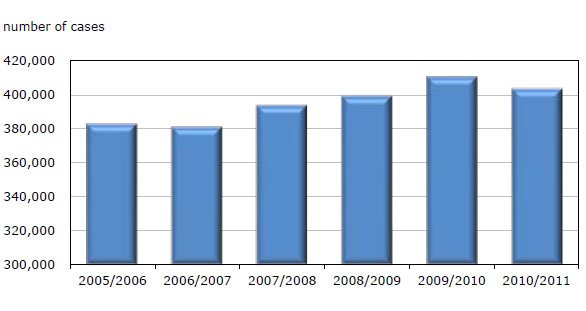
Note: A case is one or more charges against an accused person or company that were processed by the courts at the same time and received a final disposition. Data begin in 2005/2006 when information from all provincial and territorial courts became available. In total, data represent approximately 95% of the national adult criminal court caseload. Excludes information from superior courts in Prince Edward Island, Quebec, Ontario, Manitoba and Saskatchewan as well as municipal courts in Quebec due to the unavailability of data.
Source: Statistics Canada, Canadian Centre for Justice Statistics, Integrated Criminal Court Survey.
Although the overall number of adult criminal court cases remained relatively steady, there were fewer cases completed in several provinces, most notably, British Columbia (-7%), Alberta (-6%) and Quebec (-6%) (Table 2). The decline in these provinces, however, was offset by increases in the number of cases completed in other areas of the country, including Saskatchewan (+5%) which also reported the highest provincial rate of adult court cases, and Ontario (+2%).
There are many factors that may influence the number and types of cases completed in a particular jurisdiction.Note 3 These may include Crown and police charging practices, the use of stays, withdrawals and dismissals, the distribution of offences, and various forms of alternative measures programs. These types of programs divert people accused of less serious crimes out of the formal justice system by dealing with them through non-judicial, community-based alternatives (such as personal service or financial compensation to the victim, community service or educational sessions).
Most adult criminal court cases involve non-violent offences
Similar to crime trends in general, most cases completed in adult criminal courts involve non-violent offences.Note 4 In 2010/2011, about three-quarters (77%) of all cases involved property offences, administration of justice offences, traffic offences or other non-violent Criminal Code or federal statute offences. Violent offences accounted for the remaining 23% of adult court cases.
More specifically, ten offences accounted for about 7 in 10 cases completed in adult criminal courts in 2010/2011. Among the most common were impaired driving (12%), theft (11%), common assault (9%), failure to comply with a court order (9%), and breach of probation (8%) (Chart 2).
Chart 2
Ten most common offences for cases completed in adult criminal court, Canada, 2010/2011
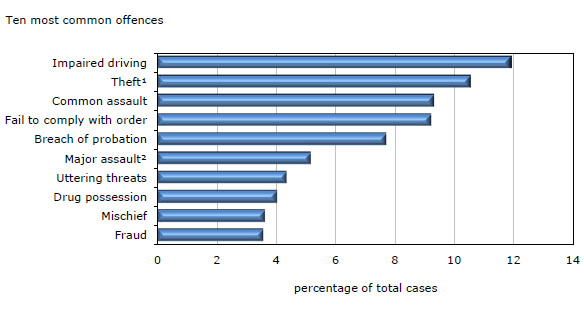
1. Includes, for example, theft over and under $5,000 as well as taking a motor vehicle without consent.
2. Includes, for example, assault with a weapon (level 2) and aggravated assault (level 3).
Note: A case is one or more charges against an accused person or company that were processed by the courts at the same time and received a final disposition. Cases that involve more than one charge are represented by the most serious offence. In total, data represent approximately 95% of the national adult criminal court caseload. Excludes information from superior courts in Prince Edward Island, Quebec, Ontario, Manitoba and Saskatchewan as well as municipal courts in Quebec due to the unavailability of data.
Source: Statistics Canada, Canadian Centre for Justice Statistics, Integrated Criminal Court Survey.
Between 2009/2010 and 2010/2011, virtually all types of cases involving violent crime remained stable or decreased (Table 3). More specifically, there were about 3,300 fewer cases involving violent offences (down by 3%) which included drops in cases for attempted murder, robbery, sexual assault, major assault, common assault and uttering threats. Cases involving homicideNote 5 and criminal harassment remained stable.
The main exception to the trend in violent crime cases was among 'other sexual offences', a crime category comprised predominantly of child-specific offences (e.g., sexual interference). Combined, 'other sexual offences' rose for the fourth year in a row, including an 11% increase (or about 220 more cases) between 2009/2010 and 2010/2011.
For adult court cases involving non-violent offences, the overall number was similar between 2009/2010 and 2010/2011. For example, there was little change in the number of cases involving theft, the largest category of property crime cases. That said, there were fewer adult criminal court cases for fraud (-5%) and break and enter (-4%) completed over the same period.
Cases involving administration of justice offences, such as failure to comply with a court order and breach of probation, accounted for about 1 in 5 (21%) cases completed in adult criminal courts in 2010/2011. Although the number of such cases remained stable between 2009/2010 and 2010/2011, these types of cases have been gradually rising over the past decade, up 35% since 2000/2001.Note 6
Following three consecutive annual increases, there were about 1,400 fewer impaired driving cases (-3%) in 2010/2011 than in 2009/2010. Similarly, the number of cases involving production, trafficking, importing and exporting decreased in 2010/2011 (down, as a whole, by about 670 cases or -5%), although cases for drug possession increased (up by almost 920 cases or +6%).
Young adults over-represented in criminal court cases
Research based upon policing data indicates that crime rates generally peak in early adulthood and decrease thereafter (Brennan and Dauvergne 2011). Data on adult criminal court cases show a similar pattern, despite the fact that not all crimes that come to the attention of police necessarily proceed to court. For example, while those aged 18 to 24 years accounted for 30% of persons accused in adult criminal court in 2010/2011, this same age group represented 12% of the adult population. In contrast, those aged 55 years and older accounted for 6% of accused adults yet represented 33% of the adult population. The decrease in the number of court cases by increasing age holds true for both men and women (Chart 3).
Chart 3
Cases completed in adult criminal court, by age group and sex of the accused, Canada, 2010/2011
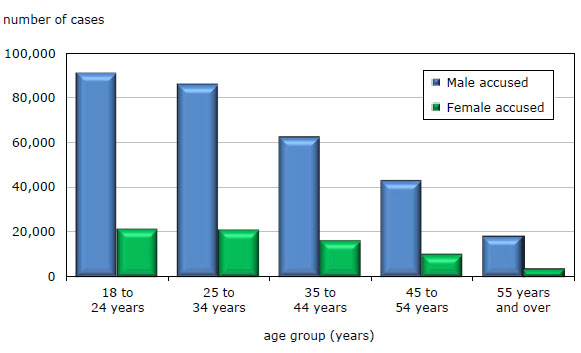
Note: Includes information on accused persons aged 18 years or over at the time of the offence. Excludes cases in which the age and/or the sex of the accused was unknown. A case is one or more charges against an accused person or company that were processed by the courts at the same time and received a final disposition. In total, data represent approximately 95% of the national adult criminal court caseload. Excludes information from Manitoba, superior courts in Prince Edward Island, Quebec, Ontario, and Saskatchewan as well as municipal courts in Quebec due to the unavailability of data.
Source: Statistics Canada, Canadian Centre for Justice Statistics, Integrated Criminal Court Survey.
The over-representation of young adults as accused persons holds true regardless of the type of case. That said, there were some types of adult criminal court cases, particularly some of the most violent ones, for which the share of 18- to 24 year-olds was greater than others. For example, the proportions of young adults accused in cases of robbery (50%), homicide (45%) and attempted murder (40%) were more than double those for criminal harassment (17%) and other sexual offences (19%).
As is also consistent with police-reported data, most cases in adult criminal court involve men. In 2010/2011, men accounted for about 8 in 10 persons accused in adult court cases (81%) while women accounted for about 2 in 10 (19%). Less than 1% of criminal court cases in 2010/2011 involved a company.
The proportion of men accused in cases for sexual assault and other sexual offences was particularly high at 98% and 97%, respectively. Cases for which the proportion of women was highest were largely non-violent in nature and included theft (35%) and fraud (31%).
Guilty findings remain stable in 2010/2011
In general, cases disposed of in adult criminal courts typically result in one of three decisions or outcomes. First, and most common, is a finding of guilt in which the accused person pleads guilty or is determined by the court to be responsible for having attempted or committed a criminal offence.Note 7 Second, case proceedings may be stopped or interrupted for a variety of reasons (e.g., lack of sufficient evidence or referral to an alternative measures program) resulting in charges being stayed (suspended for up to one year), withdrawn, dismissed or discharged at preliminary inquiry. Lastly, a relatively small proportion of cases result in an acquittal in which the accused person is found not guilty of the charges presented before the court.Note 8
In 2010/2011, a guilty finding was reached in about two-thirds (64%) of cases, a proportion that has remained relatively consistent over the past decade. Another 32% of cases were stayed, withdrawn, dismissed or discharged at preliminary inquiry, and 3% were acquitted. The remaining 1% of cases resulted in another type of decision such as the accused being found not criminally responsible or unfit to stand trial, the court's acceptance of a special plea, or cases that raised Charter arguments (Table 4).
There was some variation in case decisions depending on the province or territory. More specifically, in 2010/2011, the proportion of guilty findings was highest in Prince Edward Island where 80% of all adult criminal court cases resulted in a finding of guilt. In comparison, the lowest proportion was in Ontario, at 56% (Chart 4).
Chart 4
Guilty cases in adult criminal court, by province and territory, 2010/2011
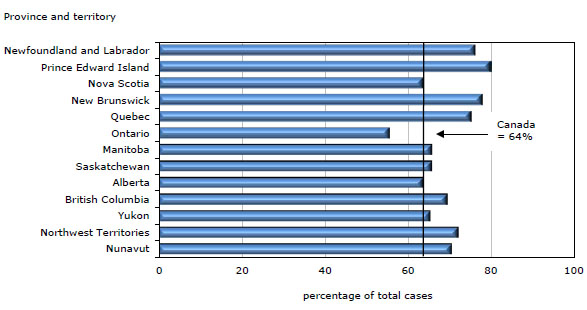
Note: A case is one or more charges against an accused person or company that were processed by the courts at the same time and received a final disposition. In total, data represent approximately 95% of the national adult criminal court caseload. Excludes information from superior courts in Prince Edward Island, Quebec, Ontario, Manitoba and Saskatchewan as well as municipal courts in Quebec due to the unavailability of data. There are many factors that may influence variations between jurisdictions, therefore, comparisons should be made with caution.
Source: Statistics Canada, Canadian Centre for Justice Statistics, Integrated Criminal Court Survey.
Court decisions may be affected by the use of pre-charge screening. Pre-charge screening refers to a formal process whereby a Crown prosecutor (as opposed to police) determines whether a charge is officially laid and proceeds to court. Pre-charge screening systems are in place in New Brunswick, Quebec and British Columbia, where the proportions of guilty findings were among the highest in the country in 2010/2011.
Another factor that may have an impact on the types of decisions reached in adult criminal court is plea negotiations or "plea bargaining". Plea negotiations involve an agreement by the accused to plead guilty in return for the prosecutor agreeing to take or refrain from taking a particular course of action (Verdun-Jones 2012). Broadly speaking, agreements may relate to the nature of the charges, the sentence, or the facts that may be presented in court. The extent to which plea negotiations are utilized in Canada is unknown.
Cases involving violent offences result in guilty findings less often than other cases
Cases involving some types of offences tend to result in a guilty finding less often than others. For example, in 2010/2011, cases involving violent offences were less likely than those for administration of justice offences or property offences to result in a finding of guilt (52% versus 71% and 60%, respectively) (Table 4).
Within these larger offence categories, however, there is considerable variation in the types of decisions reached by courts. Among violent cases, those involving 'other sexual offences' and robbery resulted in a finding of guilt most often, at 68% and 65% of all such completed cases in 2010/2011. In contrast, cases of attempted murder resulted in a finding of guilt least often, at 17% of all such cases. Most adult criminal court cases of attempted murder (68%) were stayed, withdrawn or dismissed.
Among administration of justice offences, cases involving failure to appear (47%) resulted in a guilty finding far less often than those involving offences of unlawfully at large (83%) or breach of probation (79%). Similarly, among cases for property offences, those for break and enter saw the highest proportion of guilty cases (69%) while possession of stolen property saw the lowest (48%).
Probation most common sentence imposed in adult criminal court
In Canada, judges are responsible for imposing sentences upon those who are guilty of a criminal offence. In doing so, they must consider the key principles of sentencing, including the protection of society, the rehabilitation of offenders and crime prevention. As well, judges may weigh certain mitigating or aggravating factors associated with the incident such as the type and gravity of the offence, the extent of harm inflicted upon the victim, and the number and nature of the accused person's previous convictions (Department of Justice 2005a). Given the complexities associated with determining an appropriate sanction, many cases result in more than one type of sentence (e.g., custody and probation).
In 2010/2011, probation, either on its own or in combination with other sanctions, was the most common type of sentence imposed in adult criminal courts, at 45% of all guilty cases (Table 5, Chart 5). Offenders sentenced to a term of probation remain in the community and are subject to a number of conditions (e.g., keep the peace, appear in court as required, or community service) which may vary from case to case. Probation sentences have been the most common type of sentence for more than a decade.Note 9 In most provinces and territories, the median length of probation in 2010/2011 was 365 days (1 year). The main exception was in Saskatchewan where the median length was 270 days (or nine months).
Chart 5
Guilty cases in adult criminal court, by type of sentence, Canada, 2010/2011
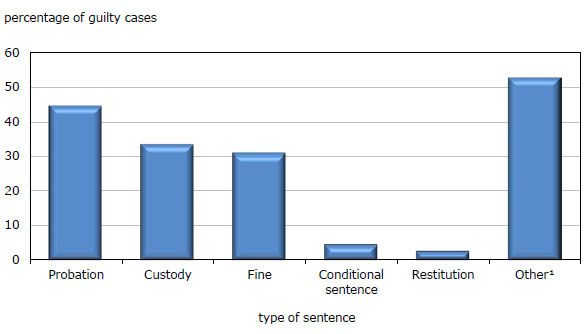
1. Includes, for example, absolute and conditional discharge, suspended sentence, community service order and prohibition order.
Note: Cases may involve more than one type of sentence, therefore, percentages do not total 100%. A case is one or more charges against an accused person or company that were processed by the courts at the same time and received a final disposition. In total, data represent approximately 95% of the national adult criminal court caseload. Excludes information from superior courts in Prince Edward Island, Quebec, Ontario, Manitoba and Saskatchewan as well as municipal courts in Quebec due to the unavailability of data.
Source: Statistics Canada, Canadian Centre for Justice Statistics, Integrated Criminal Court Survey.
Another relatively common type of adult court sentence is a fine, imposed in nearly one-third (31%) of adult criminal court cases in 2010/2011. After determining an offender's ability to pay, judges may opt to impose a fine of up to $5,000 for less serious offences (e.g., disturbing the peace, trespassing) and any amount for more serious offences. Over the past 10 years, the median amount of fines rose from $500 in 2000/2001 to $1,000 in 2010/2011.Note 10
Custody sentences imposed most often in Prince Edward Island
Custody sentences are those that involve a person being sentenced to a secure facility or a prison for a specified period of time. In Canada, there are two levels of custody for adults—provincial custody which involves sentences up to two years less a day and federal custody which involves sentence of two years or more.
Custodial sentences were imposed in about one-third (33%) of guilty adult criminal court cases completed in 2010/2011, similar to the proportion seen over the past decade.Note 11 In 2010/2011, the majority (86%) of all sentences to custody were relatively short, at six months or less. About 10% were sentenced to a period of six months to two years less a day and 4% received a sentence of two or more years (Chart 6).Note 12
Chart 6
Guilty cases in adult criminal court, by length of custody sentence, Canada, 2010/2011
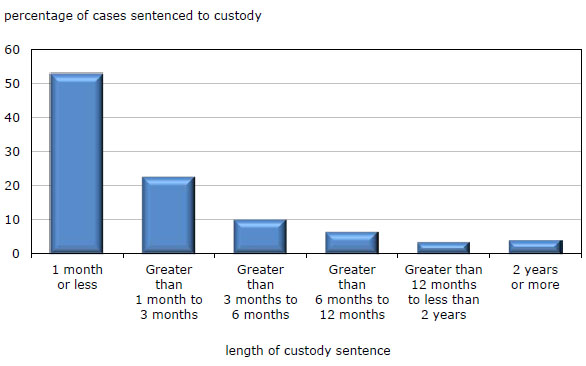
Note: Custodial sentence lengths exclude time spent in custody prior to sentencing and/or the amount of credit awarded for time spent in pre-sentence custody. Excludes cases in which the length of the custody sentence was unknown. A case is one or more charges against an accused person or company that were processed by the courts at the same time and received a final disposition. In total, data represent approximately 95% of the national adult criminal court caseload. Excludes information from superior courts in Prince Edward Island, Quebec, Ontario, Manitoba and Saskatchewan as well as municipal courts in Quebec due to the unavailability of data.
Source: Statistics Canada, Canadian Centre for Justice Statistics, Integrated Criminal Court Survey.
There is considerable variation in the use of custody across different provinces and territories. Of particular note is Prince Edward Island where custodial sentences tend to be imposed more frequently than in other provinces and territories. More specifically, in 2010/2011, 63% of all guilty cases in Prince Edward Island resulted in a custodial sentence, more than double the lowest proportions found in Nunavut (23%), Nova Scotia (25%) and New Brunswick (26%) (Chart 7). At the same time, however, the median length of custody was shortest in Prince Edward Island, at 14 days. This was about half the median length of custody for Canada as a whole (30 days) (Chart 8).Note 13
Chart 7
Guilty cases in adult criminal court sentenced to custody, by province and territory, 2010/2011
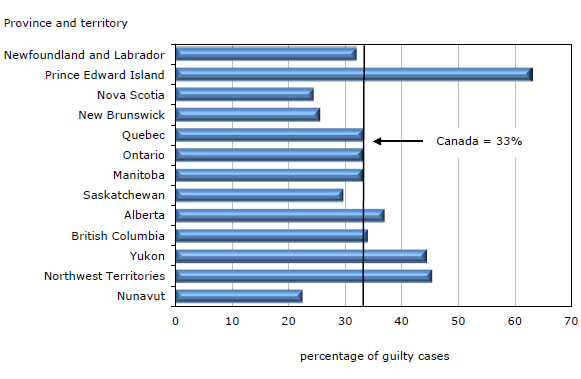
Note: A case is one or more charges against an accused person or company that were processed by the courts at the same time and received a final disposition. In total, data represent approximately 95% of the national adult criminal court caseload. Excludes information from superior courts in Prince Edward Island, Quebec, Ontario, Manitoba and Saskatchewan as well as municipal courts in Quebec due to the unavailability of data. There are many factors that may influence variations between jurisdictions, therefore, comparisons should be made with caution.
Source: Statistics Canada, Canadian Centre for Justice Statistics, Integrated Criminal Court Survey.
Chart 8
Median length of custody for guilty cases in adult criminal court, by province and territory, 2010/2011
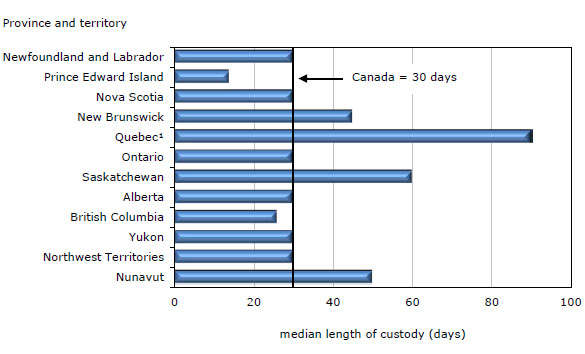
1. The median length of custody in Quebec may be over-estimated given that data from municipal courts, which tend to handle the least serious matters, are unavailable.
Note: The median represents the midpoint, where exactly half the custody sentences are above and half are below. Excludes information from Manitoba, superior courts in Prince Edward Island, Quebec, Ontario, and Saskatchewan as well as municipal courts in Quebec due to the unavailability of data. There are many factors that may influence variations between jurisdictions, therefore, comparisons should be made with caution.
Source: Statistics Canada, Canadian Centre for Justice Statistics, Integrated Criminal Court Survey.
One reason for the relatively high proportion of custodial sentences in Prince Edward Island in 2010/2011 relates to cases of impaired driving. Not only did impaired driving cases comprise a larger proportion of all guilty cases in Prince Edward Island than elsewhere in Canada (28% versus 16%), but courts in Prince Edward Island were far more likely to sentence these types of cases to custody (93% versus 8% for Canada) (Chart 9). In other provinces and territories, fines were more typically imposed for impaired driving.Note 14, Note 15
Chart 9
Impaired driving cases sentenced to custody in adult criminal court, by province and territory, 2010/2011
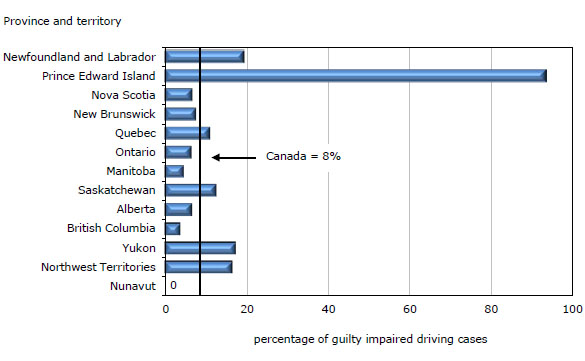
Note: Cases that involve more than one charge are represented by the most serious offence. In total, data represent approximately 95% of the national adult criminal court caseload. Excludes information from superior courts in Prince Edward Island, Quebec, Ontario, Manitoba and Saskatchewan as well as municipal courts in Quebec due to the unavailability of data. There are many factors that may influence variations between jurisdictions, therefore, comparisons should be made with caution.
Source: Statistics Canada, Canadian Centre for Justice Statistics, Integrated Criminal Court Survey.
Geographical differences in the use of custody can also be seen for other types of cases. While the majority of the most serious violent cases with a guilty finding, namely homicide, attempted murder and robbery, resulted in a custodial sentence in all provinces and territories, there was considerable variation in other types of cases, such as major assault (Chart 10) and break and enter (Chart 11).
Chart 10
Major assault cases sentenced to custody in adult criminal court, by province and territory, 2010/2011
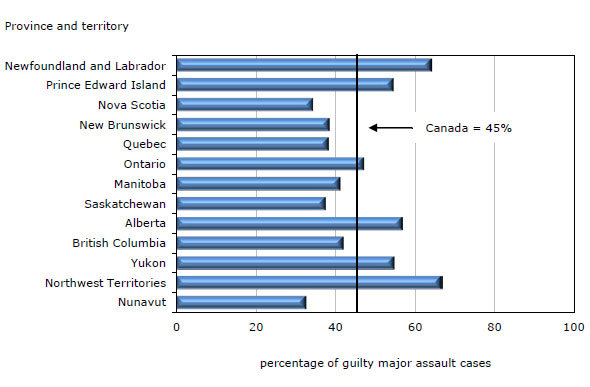
Note: Major assault includes assault with a weapon or causing bodily harm, aggravated assault and other major assaults (e.g., assaulting a police officer). Cases that involve more than one charge are represented by the most serious offence. In total, data represent approximately 95% of the national adult criminal court caseload. Excludes information from superior courts in Prince Edward Island, Quebec, Ontario, Manitoba and Saskatchewan as well as municipal courts in Quebec due to the unavailability of data. There are many factors that may influence variations between jurisdictions, therefore, comparisons should be made with caution.
Source: Statistics Canada, Canadian Centre for Justice Statistics, Integrated Criminal Court Survey.
Chart 11
Break and enter cases sentenced to custody in adult criminal court, by province and territory, 2010/2011
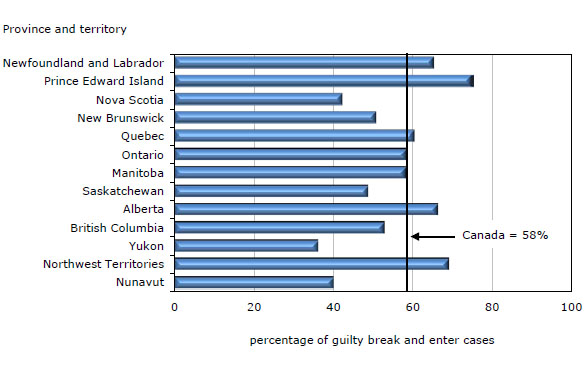
Note: Cases that involve more than one charge are represented by the most serious offence. In total, data represent approximately 95% of the national adult criminal court caseload. Excludes information from superior courts in Prince Edward Island, Quebec, Ontario, Manitoba and Saskatchewan as well as municipal courts in Quebec due to the unavailability of data. There are many factors that may influence variations between jurisdictions, therefore, comparisons should be made with caution.
Source: Statistics Canada, Canadian Centre for Justice Statistics, Integrated Criminal Court Survey.
Time taken to complete adult criminal court cases declines for second year in a row
According to the Canadian Charter of Rights and Freedoms, accused persons have a fundamental right to be brought to trial in a timely manner.Note 16 While there is no prescribed time limit within which criminal court cases must be completed, an 8 to 10 month period is generally considered to be reasonable.Note 17
Following a period of relative stability from 2005/2006 to 2008/2009, the median amount of time from first court appearance to case completion fell for the second year in a row to 118 days (about 4 months) in 2010/2011. Despite recent declines, however, the elapsed period of time remained higher than a decade ago when the median length was 101 days.Note 18
There was considerable provincial and territorial variation in the amount of time taken to complete adult criminal court cases in 2010/2011. As has been consistent over the past decade, the shortest median length of time was in Prince Edward Island at 29 days, about four times lower than the median length for Canada as a whole (Table 2, Chart 12).Note 19
Chart 12
Median length of cases completed in adult criminal court, by province and territory, 2010/2011
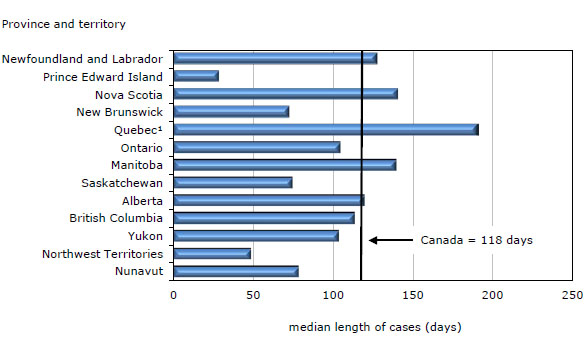
1. The median length of case completion in Quebec may be over-estimated given that data from municipal courts, which tend to handle the least serious matters, are unavailable.
Note: The median represents the mid-point of the number of days taken to complete a case, from the first to last court appearance. A case is one or more charges against an accused person or company that were processed by the courts at the same time and received a final disposition. In total, data represent approximately 95% of the national adult criminal court caseload. Excludes information from superior courts in Prince Edward Island, Quebec, Ontario, Manitoba and Saskatchewan as well as municipal courts in Quebec due to the unavailability of data. There are many factors that may influence variations between jurisdictions, therefore, comparisons should be made with caution.
Source: Statistics Canada, Canadian Centre for Justice Statistics, Integrated Criminal Court Survey.
Cases involving certain types of charges or multiple charges tend to take longer than others to complete. In 2010/2011, homicide cases generally took the longest with a median length of 391 days, followed by attempted murder (303 days) and sexual assault (300 days) (Table 3). Similarly, the median length of cases involving two or more charges was considerably longer than those involving single charges (147 days and 82 days, respectively).
Previous research has identified several other factors that tend to be associated with lengthier case completion, namely trial cases and those involving bench warrants (Thomas 2010). Trial cases are generally resource and time intensive as they often require many appearances to present evidence, hear the testimony of witnesses, and review victim impact statements. Cases involving bench warrants (i.e., those in which the court issues a warrant of arrest for an accused person who fails to appear) tend to be slowed by delays resulting from time taken to re-apprehend an accused person.
Summary
Following two consecutive annual decreases, the number of cases completed in adult criminal courts remained relatively stable in 2010/2011 at about 403,000 cases. As in previous years, cases for impaired driving and theft were the most common. Among violent crime cases, those for common assault were most frequent. Some provinces, namely British Columbia (-7%), Alberta (-6%) and Quebec (-6%), recorded fewer cases than in the previous year, yet, these drops were offset by increases in other provinces, such as Saskatchewan (+5%) and Ontario (+2%).
Case outcomes in 2010/2011 remained consistent with findings from previous years, with about two-thirds (64%) resulting in a finding of guilt. Probation was the most common type of sentence, at nearly one-half (45%) of all guilty cases. About one-third (33%) of guilty cases had a custodial sentence, though this varied considerably across provinces and territories and by different types of offences. Despite recent declines in the median number of days to complete adult court cases, the median length (118 days or nearly 4 months) remained higher than a decade ago.
Data source
The Integrated Criminal Court Survey (ICCS) is administered by the Canadian Centre for Justice Statistics (Statistics Canada) in collaboration with provincial and territorial government departments responsible for criminal courts in Canada. The survey collects statistical information on adult and youth court cases involving Criminal Code and other federal statute offences.Data contained in this article represent the adult criminal court portion of the survey, namely, individuals who were 18 years of age or older at the time of the offence.
The primary unit of analysis is a case. A case is defined as one or more charges against an accused person or company that were processed by the courts at the same time and received a final disposition. A case combines all charges against the same person having one or more key overlapping dates (date of offence, date of initiation, date of first appearance, date of decision, or date of sentencing) into a single case.
A case that has more than one charge is represented by the charge with the "most serious offence" (MSO). The most serious offence is selected using the following rules. First, court decisions are considered and the charge with the "most serious decision" (MSD) is selected. Court decisions for each charge in a case are ranked from most to least serious as follows: (1) guilty, (2) guilty of a lesser offence, (3) acquitted, (4) stay of proceeding, (5) withdrawn, dismissed or discharged, (6) not criminally responsible, (7) other, and (8) transfer of court jurisdiction.
Second, in cases where two or more charges result in the same MSD (e.g., guilty), Criminal Code sanctions are considered. The charge with the most serious offence type is selected according to an offence seriousness scale, based on actual sentences handed down by courts in Canada.Note 20 Each offence type is ranked by looking at (1) the proportion of guilty charges where custody was imposed and (2) the average (mean) length of custody for the specific type of offence. These values are multiplied together to arrive at the final seriousness ranking for each type of offence. If, after looking at the offence seriousness scale, two or more charges remain tied then information about the sentence type and duration of the sentence are considered (e.g., custody and length of custody, then probation and length of probation, etc.).
In 2010/2011, coverage of the ICCS represented approximately 95% of the total adult caseload completed in Canadian criminal courts. As in previous years, information from superior courts in Prince Edward Island, Quebec, Ontario, Manitoba and Saskatchewan as well as municipal courts in Quebec (which accounted for about one-quarter of all Criminal Code charges in that province) could not be extracted from their electronic reporting systems and was therefore unavailable.
The absence of data from superior courts in these five jurisdictions may have resulted in a slight underestimation of the severity of sentences since some of the most serious cases, which are likely to result in the most severe sanctions, are processed in superior courts. There may also be a slight underestimation of case elapsed times as more serious cases generally require more court appearances and take more time to complete.
Cases are counted according to the fiscal year in which they are completed. Each year, the ICCS database is "frozen" at the end of March for the production of court statistics pertaining to the preceding fiscal year. However, these counts do not include cases that were pending an outcome at the end of the reference period. Once an outcome is reached, or a one-year period of inactivity elapses, these cases are deemed complete and are subsequently updated and reported in the next year's release of the data. For example, upon the release of 2010/2011 data, the 2009/2010 data are updated with revisions that were determined when processing data for the next fiscal year. Data are revised once and are then permanently "frozen". Historically, updates to a previous year's numbers have resulted in an increase of about 2%.
Lastly, there are many factors that influence variations between jurisdictions. These may include Crown and police charging practices, offence distributions, and various forms of diversion programs. Therefore, any comparisons between jurisdictions should be interpreted with caution.
Detailed data tables
Table 1 Charges and cases completed in adult criminal court, Canada, 2005/2006 to 2010/2011
Table 2 Cases completed in adult criminal court, by province and territory, 2009/2010 and 2010/2011
Table 3 Cases completed in adult criminal court, by type of offence, Canada, 2009/2010 and 2010/2011
Table 4 Cases completed in adult criminal court, by type of offence and decision, Canada, 2010/2011
References
Brennan, Shannon. 2012. "Youth court statistics, 2010/2011." Juristat. Statistics Canada Catalogue no. 85-002-X.
Brennan, Shannon and Mia Dauvergne. 2011. "Police-reported crime statistics in Canada, 2010." Juristat. Statistics Canada Catalogue no. 85-002-X. (accessed January 23, 2012).
Department of Justice Canada. 2005a. Backgrounder: Fair and Effective Sentencing – A Canadian Approach to Sentencing Policy. (accessed February 20, 2012).
Department of Justice Canada. 2005b. Canada's Court System. Catalogue no. J2-128/2005. (accessed February 20, 2012).
Perreault, Samuel. 2012. "Impaired driving in Canada, 2010." Juristat. Statistics Canada Catalogue no. 85-002-X.
Thomas, Jennifer. 2010. "Adult criminal court statistics, 2008/2009." Juristat. Statistics Canada Catalogue no. 85-002-X. (accessed February 20, 2012).
Verdun-Jones, Simon. 2012. "Plea bargaining." Criminal Justice in Canada. 4th edition. Julian V. Roberts and Michelle G. Grossman (eds). Toronto, Ontario: Nelson Education Ltd.
Notes
- For information on 2010/2011 youth court statistics in Canada, see Brennan 2012.
- At the time of this publication, information reported to Statistics Canada shows a 1.7% decline between 2009/2010 and 2010/2011 in the number of completed adult court cases. However, it is expected that updates received at a later date will result in an additional 2% in the number of cases for 2010/2011. For further information, see Data source section.
- Given the possible influence of various factors on the number and types of cases completed in adult criminal courts, comparisons between jurisdictions should be interpreted with caution.
- Adult criminal court cases that involve more than one charge are represented by the most serious offence. For further information, see Data source section.
- First and second degree murder cases are under the exclusive jurisdiction of superior courts. As such, information on these types of cases is missing from Prince Edward Island, Quebec, Ontario, Manitoba and Saskatchewan where superior court data are unavailable.
- Based upon information from ten provinces and territories that have consistently reported to the adult component of the ICCS since 2000/2001.
- Guilty findings include guilty of the offence, of an included offence, of an attempt of the offence, or of an attempt of an included offence. Also includes cases where an absolute or conditional discharge has been imposed.
- In Newfoundland and Labrador, the terms 'acquittal' and 'dismissed' are used interchangeably, resulting in an under-count of the number of acquittals in that province. In other provinces, the number of acquittals may be over-counted due to administrative practices.
- See Note 6.
- See Note 6.
- See Note 6.
- Custodial sentence lengths exclude time spent in custody prior to sentencing and/or the amount of credit awarded for time spent in pre-sentence custody.
- Excludes information from Manitoba, superior courts in Prince Edward Island, Quebec, Ontario, and Saskatchewan as well as municipal courts in Quebec due to the unavailability of data.
- For further information on impaired driving statistics, see Perreault 2012.
- Due to the unavailability of information from superior courts in Prince Edward Island, Quebec, Ontario, Manitoba and Saskatchewan as well as jurisdictional differences in the structure and operation of courts, comparisons should be interpreted with caution.
- See Constitution Act, 1982. Part 1. The Charter of Rights and Freedoms, s. 11.
- See R. v. Askov [1990], 2 S.C.R. 1199.
- See Note 6.
- See Note 13.
- The offence seriousness scale is calculated using data from both the adult and youth components of the Integrated Criminal Court Survey from 2002/2003 to 2006/2007.
- Date modified:
